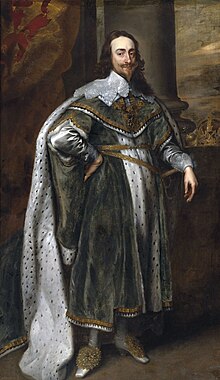| Charles I | |
|---|---|
 | |
| King of England and Ireland | |
| Reign | 27 March 1625 – 30 January 1649 |
| Coronation | 2 February 1626 |
| Predecessor | James I |
| Successor | |
| King of Scotland | |
| Reign | 27 March 1625 – 30 January 1649 |
| Coronation | 18 June 1633 |
| Predecessor | James VI |
| Successor | Charles II |
| Born | 19 November 1600 Dunfermline Palace, Dunfermline, Scotland |
| Died | 30 January 1649 (aged 48) Whitehall, Westminster, England |
| Cause of death | Execution by decapitation |
| Burial | 9 February 1649 St George's Chapel, Windsor Castle, England |
| Spouse | |
| Issue more... | |
| House | Stuart |
| Father | James VI and I |
| Mother | Anne of Denmark |
| Religion | Protestant |
| Signature |  |
Charles I (19 November 1600 – 30 January 1649)[a] was King of England, Scotland, and Ireland from 27 March 1625 until his execution in 1649.
Charles was born into the House of Stuart as the second son of King James VI of Scotland, but after his father inherited the English throne in 1603, he moved to England, where he spent much of the rest of his life. He became heir apparent to the kingdoms of England, Scotland, and Ireland in 1612 upon the death of his elder brother, Henry Frederick, Prince of Wales. An unsuccessful and unpopular attempt to marry him to Infanta Maria Anna of Spain culminated in an eight-month visit to Spain in 1623 that demonstrated the futility of the marriage negotiation. Two years later, shortly after his accession, he married Henrietta Maria of France.
After his succession in 1625, Charles quarrelled with the English Parliament, which sought to curb his royal prerogative. He believed in the divine right of kings, and was determined to govern according to his own conscience. Many of his subjects opposed his policies, in particular the levying of taxes without Parliamentary consent, and perceived his actions as those of a tyrannical absolute monarch. His religious policies, coupled with his marriage to a Roman Catholic, generated antipathy and mistrust from Reformed religious groups such as the English Puritans and Scottish Covenanters, who thought his views too Catholic. He supported high church Anglican ecclesiastics and failed to aid continental Protestant forces successfully during the Thirty Years' War. His attempts to force the Church of Scotland to adopt high Anglican practices led to the Bishops' Wars, strengthened the position of the English and Scottish parliaments, and helped precipitate his own downfall.
From 1642, Charles fought the armies of the English and Scottish parliaments in the English Civil War. After his defeat in 1645 at the hands of the Parliamentarian New Model Army, he fled north from his base at Oxford. Charles surrendered to a Scottish force and after lengthy negotiations between the English and Scottish parliaments he was handed over to the Long Parliament in London. Charles refused to accept his captors' demands for a constitutional monarchy, and temporarily escaped captivity in November 1647. Re-imprisoned on the Isle of Wight, he forged an alliance with Scotland, but by the end of 1648, the New Model Army had consolidated its control over England. Charles was tried, convicted, and executed for high treason in January 1649. The monarchy was abolished and the Commonwealth of England was established as a republic. The monarchy was restored in 1660, with Charles's son Charles II as king.
Cite error: There are <ref group=lower-alpha> tags or {{efn}} templates on this page, but the references will not show without a {{reflist|group=lower-alpha}} template or {{notelist}} template (see the help page).